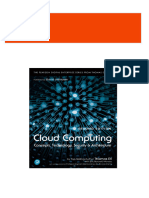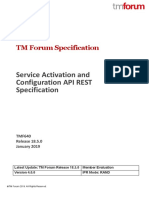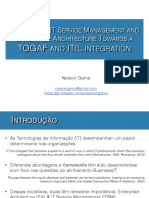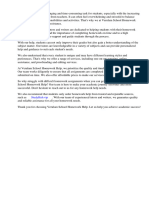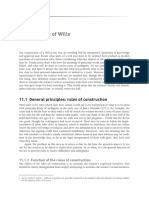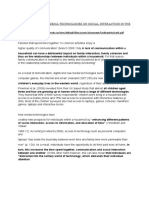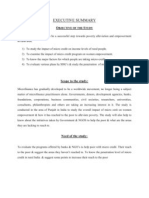TR206 Exploring SES Service Development Scenarios Through ITIL and The Process Framework v1.3
TR206 Exploring SES Service Development Scenarios Through ITIL and The Process Framework v1.3
Uploaded by
Roosvelt GarcíaCopyright:
Available Formats
TR206 Exploring SES Service Development Scenarios Through ITIL and The Process Framework v1.3
TR206 Exploring SES Service Development Scenarios Through ITIL and The Process Framework v1.3
Uploaded by
Roosvelt GarcíaOriginal Title
Copyright
Available Formats
Share this document
Did you find this document useful?
Is this content inappropriate?
Copyright:
Available Formats
TR206 Exploring SES Service Development Scenarios Through ITIL and The Process Framework v1.3
TR206 Exploring SES Service Development Scenarios Through ITIL and The Process Framework v1.3
Uploaded by
Roosvelt GarcíaCopyright:
Available Formats
TM Forum
Exploring SES Service Development Scenarios through
ITIL and the Process Framework
August 2013
TM Forum Approved Version 1.3.1
IPR Mode: RAND
Exploring SES Service Development Scenarios through ITIL and the Process Framework
Notice
Copyright © TM Forum 2014. All Rights Reserved.
This document and translations of it may be copied and furnished to others, and derivative
works that comment on or otherwise explain it or assist in its implementation may be prepared,
copied, published, and distributed, in whole or in part, without restriction of any kind, provided
that the above copyright notice and this section are included on all such copies and derivative
works. However, this document itself may not be modified in any way, including by removing
the copyright notice or references to TM FORUM, except as needed for the purpose of
developing any document or deliverable produced by a TM FORUM Collaboration Project Team
(in which case the rules applicable to copyrights, as set forth in the TM FORUM IPR Policy, must
be followed) or as required to translate it into languages other than English.
The limited permissions granted above are perpetual and will not be revoked by TM FORUM or
its successors or assigns.
This document and the information contained herein is provided on an "AS IS" basis and TM
FORUM DISCLAIMS ALL WARRANTIES, EXPRESS OR IMPLIED, INCLUDING BUT NOT LIMITED TO
ANY WARRANTY THAT THE USE OF THE INFORMATION HEREIN WILL NOT INFRINGE ANY
OWNERSHIP RIGHTS OR ANY IMPLIED WARRANTIES OF MERCHANTABILITY OR FITNESS FOR A
PARTICULAR PURPOSE.
TM FORUM invites any TM FORUM Member or any other party that believes it has patent
claims that would necessarily be infringed by implementations of this TM Forum Standards
Final Deliverable, to notify the TM FORUM Team Administrator and provide an indication of its
willingness to grant patent licenses to such patent claims in a manner consistent with the IPR
Mode of the TM FORUM Collaboration Project Team that produced this deliverable.
The TM FORUM invites any party to contact the TM FORUM Team Administrator if it is aware of
a claim of ownership of any patent claims that would necessarily be infringed by
implementations of this TM FORUM Standards Final Deliverable by a patent holder that is not
willing to provide a license to such patent claims in a manner consistent with the IPR Mode of
the TM FORUM Collaboration Project Team that produced this TM FORUM Standards Final
Deliverable. TM FORUM may include such claims on its website, but disclaims any obligation to
do so.
TM FORUM takes no position regarding the validity or scope of any intellectual property or
other rights that might be claimed to pertain to the implementation or use of the technology
described in this TM FORUM Standards Final Deliverable or the extent to which any license
under such rights might or might not be available; neither does it represent that it has made
© TM Forum 2014. All Rights Reserved. Page 2 of 14
Exploring SES Service Development Scenarios through ITIL and the Process Framework
any effort to identify any such rights. Information on TM FORUM's procedures with respect to
rights in any document or deliverable produced by a TM FORUM Collaboration Project Team
can be found on the TM FORUM website. Copies of claims of rights made available for
publication and any assurances of licenses to be made available, or the result of an attempt
made to obtain a general license or permission for the use of such proprietary rights by
implementers or users of this TM FORUM Standards Final Deliverable, can be obtained from the
TM FORUM Team Administrator. TM FORUM makes no representation that any information or
list of intellectual property rights will at any time be complete, or that any claims in such list
are, in fact, Essential Claims.
Direct inquiries to the TM Forum office:
240 Headquarters Plaza,
East Tower – 10th Floor,
Morristown, NJ 07960 USA
Tel No. +1 973 944 5100
Fax No. +1 973 944 5110
TM Forum Web Page: www.tmforum.org
© TM Forum 2014. All Rights Reserved. Page 3 of 14
Exploring SES Service Development Scenarios through ITIL and the Process Framework
Contents
Notice .............................................................................................................................................. 2
Contents .......................................................................................................................................... 4
Figures ............................................................................................................................................. 4
Introduction .................................................................................................................................... 5
Scenario 1: Developing a Digital Service Upgrade .......................................................................... 5
Overview ..................................................................................................................................... 5
Scope ........................................................................................................................................... 6
Service Development & Retirement Process Elements .............................................................. 7
Utilizing ITIL for Process Flows .................................................................................................... 9
Administrative Appendix .............................................................................................................. 14
Document History ..................................................................................................................... 14
Version History ...................................................................................................................... 14
Release History ...................................................................................................................... 14
Figures
Figure 1 - Scope in Process Framework terms of this Scenario (red enclosure) ............................ 7
Figure 2 - Service Development & Retirement and its level 3 and level 4 children ....................... 9
Figure 3 - ITIL Change Management – swimlanes (pre-approval stage) ....................................... 9
Figure 4 - ITIL Change Management – swimlanes (post-approval stage) ..................................... 10
Figure 5 – Service Development Change Management – (pre-approval stage)........................... 11
Figure 6 – Service Development Change Management – (post-approval stage) ......................... 11
Figure 7 – Service Development Level 4 Change Management – (pre-approval stage) .............. 12
Figure 8 – Process Framework and Service Development Change Management ........................ 13
© TM Forum 2014. All Rights Reserved. Page 4 of 14
Exploring SES Service Development Scenarios through ITIL and the Process Framework
Introduction
The Software Enabled Services (SES) project is developing a Digital Services Reference
Architecture (DSRA) as part of its work.
An aspect of this is how service development and deployment can be visualized using a
combination of ITIL practices and Process Framework process elements. The chosen
methodology is to use ITIL to identify steps in the lifecycle, and to map into the Process
Framework in the appropriate area(s) of the enterprise.
From separate TM Forum experience in linking the Process Framework with ITIL, it is
constructive to handle this by examining representative scenarios in this lifecycle, and modeling
process flows that address the scenarios. Again, from previous experience, detailed linkage with
ITIL can be examined at Level 4 of the Process Framework, and “missing” functionality required
by ITIL but not present of not explicit within the Process Framework, specified. This can then be
positioned as “candidate process functionality” elements that can be validated against the
Process Framework and, where necessary, new or modified Level 4 process elements proposed
to update the Process Framework so as then to fully address the ITIL needs. At that point, the
“candidate process functionality” elements that have now been absorbed into the main Process
Framework can then be discarded, since their functionality is now part of the Framework.
Note that this methodology requires that the chosen scenarios let us focus on the part of the
enterprise involved, so that we can choose the relevant Process Framework process elements,
and also on the ITIL practices that play a part in that scenario. This is therefore a progressive
exercise, with potentially a number of scenarios involved, that let us build up a picture of how
the DSRA is supported, and which areas of the enterprise (and thus the Process Framework)
and which ITIL practices relate to each scenario.
For this release, an initial scenario has been chosen and analyzed. This lets us explore the
scenario’s use of ITIL and the Process Framework, and also lets us demonstrate how the design
methodology is applied in practice, for insight and guidance to others.
Scenario 1: Developing a Digital Service Upgrade
Overview
During the lifetime of a digital service, some aspect of its scope may be altered, for example a
tariff change, or a change in some of its technical characteristics, or a change to its relationship
with other services. For this pass, we concentrate on the development of a digital service
© TM Forum 2014. All Rights Reserved. Page 5 of 14
Exploring SES Service Development Scenarios through ITIL and the Process Framework
upgrade, and regard as out of scope for this scenario the later deployment and operational use
(we may expand this scope in the future to embrace these areas also).
In terms of the Business Process Framework (eTOM), these development-focused changes take
us the Strategy, Infrastructure and Product (SIP) area of the Framework, and in particular the
Product Lifecycle Management column. Note this assumes we are focused on carrying through
development of the intended change, with the nature of the change already planned and
agreed elsewhere (i.e. in the Strategy & Commit area)
In terms of ITIL, a first focus is Change Management which sets out the steps for managing
changes generally. Here, we will interpret these steps in the context of the specific type of
change, and the impacted area of the enterprise (and hence Process Framework) involved. In
future passes, linkage with other ITIL practices may be added in.
An unavoidable complication in doing this is interpretation of “service”. ITIL does not
distinguish “service” and “product” as does Frameworx, and specifically as does the Process
Framework. Moreover, when talking of “digital services” in the DSRA, aspects of “product” are
also involved. We must therefore be aware of this, but as a first pass, we will here ignore this,
and analyze “Developing a Digital Service Upgrade” as if it aligns directly with the service layer
of the Process Framework model – i.e. for the SIP processes that are in scope, this involves the
“Service Development & Management” level 1 area. Note that in later passes, we will look
beyond this to enhance the results presented here at present – it is anticipated that this will
involve recursing the linkage between ITIL and the Process Framework, at the Product layer as
well as (as here) the Service layer.
Scope
In terms of the Business Process Framework (eTOM), the scope of this Scenario is the single
Level2 process element “Service Development & Retirement “(see Figure 1). We will analyze its
component Level 3s, and their component Level 4s, to explore detailed linkages with ITIL, and
to identify any “candidate process functionality” that emerges.
In terms of the IT Infrastructure Library (ITIL1), the scope of this this Scenario encompasses
activities within Change Management.
The focus of this analysis is the detailed specification and delivery of a set of processes, defined
in Business Process Management Notation (BPMN), that utilize all currently defined Business
Process Framework level 4 process elements within project scope to integrate ITIL activities in
the context of process flows.
1
ITIL® is a Registered Trade Mark of the Office of Government Commerce in the United Kingdom and other
countries.
© TM Forum 2014. All Rights Reserved. Page 6 of 14
Exploring SES Service Development Scenarios through ITIL and the Process Framework
Figure 1 - Scope in Process Framework terms of this Scenario (red enclosure)
Note that the analysis seeks to identify areas where the detail within the ITIL practices is not
explicitly supported by the existing Level 4 process descriptions within the Process Framework.
This is then an opportunity to improve the Process Framework to ensure it is fully supportive of
ITIL in the area concerned.
Service Development & Retirement Process Elements
Service Development & Retirement, shown in Figure 2, is a level 2 process at the intersection of
the Service Development & Management level 1 process with the Product Lifecycle
Management vertical. It comprises seven level 3 processes (bolded in the Figure) that
represent all service-related activities concerned with the development lifecycle of services.
Not all these level 3s are weighty enough to require decomposition to level 4, but where level4s
have been defined these are shown below the parent level 3.
Brief description from GB921-D: “Service Development & Retirement processes are project
oriented in that they develop and deliver new or enhanced service types. These processes
include process and procedure implementation, systems changes and customer
documentation. They also undertake rollout and testing of the service type, capacity
© TM Forum 2014. All Rights Reserved. Page 7 of 14
Exploring SES Service Development Scenarios through ITIL and the Process Framework
management and costing of the service type. It ensures the ability of the enterprise to deliver
service types according to requirements.”
Service Development & 1.2.2.3 (2) eTOM Process
Retirement Type
Gather & Analyze New Service 1.2.2.3.1 (3) eTOM Process
Ideas Type
Analyze Service Classes 1.2.2.3.1.2 (4) eTOM Process
Type
Assess Performance of Existing 1.2.2.3.2 (3) eTOM Process
Services Type
Develop New Service Business 1.2.2.3.3 (3) eTOM Process
Proposal Type
Develop Service Business 1.2.2.3.3.1 (4) eTOM Process
Proposal Type
Gain Service Business Proposal 1.2.2.3.3.2 (4) eTOM Process
Approval Type
Develop Detailed Service 1.2.2.3.4 (3) eTOM Process
Specifications Type
Develop Detailed Service 1.2.2.3.4.1 (4) eTOM Process
Technical Specifications Type
Develop Detailed Service 1.2.2.3.4.2 (4) eTOM Process
Support Specifications Type
Develop Detailed Service 1.2.2.3.4.3 (4) eTOM Process
Operational Specifications Type
Develop Detailed Service 1.2.2.3.4.4 (4) eTOM Process
Customer Manuals Type
Manage Service Development 1.2.2.3.5 (3) eTOM Process
Type
Manage Service Deployment 1.2.2.3.6 (3) eTOM Process
Type
Manage Service Process & 1.2.2.3.6.1 (4) eTOM Process
Procedure Implementation Type
© TM Forum 2014. All Rights Reserved. Page 8 of 14
Exploring SES Service Development Scenarios through ITIL and the Process Framework
Manage Service Operational 1.2.2.3.6.2 (4) eTOM Process
Staff Training Type
Develop Service 1.2.2.3.6.3 (4) eTOM Process
Supplier/Partner Operational Type
Support
Manage Service Acceptance 1.2.2.3.6.4 (4) eTOM Process
Testing Type
Manage Service Exit 1.2.2.3.7 (3) eTOM Process
Type
Figure 2 - Service Development & Retirement and its level 3 and level 4 children
Utilizing ITIL for Process Flows
As described TR143 “Building Bridges: eTOM and ITIL”, the ITIL Practices can be used as a
“backdrop” for the Process Framework process flows, by drawing process swimlanes that utilize
the ITIL steps.
For Change Management, this produces the following swimlane view (see Figures 3 and 4):
Figure 3 - ITIL Change Management – swimlanes (pre-approval stage)
© TM Forum 2014. All Rights Reserved. Page 9 of 14
Exploring SES Service Development Scenarios through ITIL and the Process Framework
Figure 4 - ITIL Change Management – swimlanes (post-approval stage)
Process Framework process elements are now overlaid on these swimlanes, to form Process
Framework process flows that support the associated ITIL steps and practices.
As an initial pass, this is done for Level 3 process elements (see Figures 5 and 6).
© TM Forum 2014. All Rights Reserved. Page 10 of 14
Exploring SES Service Development Scenarios through ITIL and the Process Framework
Figure 5 – Service Development Change Management – (pre-approval stage)
Figure 6 – Service Development Change Management – (post-approval stage)
© TM Forum 2014. All Rights Reserved. Page 11 of 14
Exploring SES Service Development Scenarios through ITIL and the Process Framework
Based on the level 3 flows shown above, we can extend the analysis to show level 4 process
elements, where this adds value, in Figures 7 (see following text for the post-approval level 4s
that would have been expected as a Figure):
Figure 7 – Service Development Level 4 Change Management – (pre-approval stage)
For the post-approval stage, all three level 3s, as shown in Figure 6, decompose into a number
of level 4s which are each positioned exactly as their parent level 3. To avoid a complex diagram
that adds no new understanding, we therefore note this and continue to use Figure 6 as a
positioning guide.
Now, level 4 is the lowest level of process structure available at present in the Process
Framework for these processes, so we are now able to compare the process element
descriptions there with the ITIL detail, and identify any mismatches or shortfalls, using the
available level 4 descriptions, or level 3 descriptions where these are not available, for this.
Working through the material, we can identify the following:
ITIL step Supporting Process Alignment issues (i.e. possible
Framework element Process Framework gaps)
Receive RFC (Record RFC, Gather & Analyze New None identified
Filter Request) Service Ideas
Categorize and Develop Service Business None identified
© TM Forum 2014. All Rights Reserved. Page 12 of 14
Exploring SES Service Development Scenarios through ITIL and the Process Framework
Prioritize Proposal
Pass approved changes to Gain Service Business Role of CAB is not explicit.
CAB for actioning Proposal Approval Add content on CAB (or
equivalent) as decision focus
and point of contact for liaison
with stakeholders, including
management reporting
Review impact and resources Develop Service Business Well-covered, but maybe more
Proposal words on the resources needed
would help
Approve/reject change Gain Service Business Release scheduling not explicit
Proposal Approval and should be added
Coordinate Change Build Develop Detailed Service None (note: the contained level
(including reviewing test Specifications 4s are equivalent, for different
results and back out plan) areas of specification)
Manage Service Remediation (back-up) planning
“ Development not explicit and should be added
Manage Service Remediation (back-up), if
“ Deployment required, not explicit and should
be added
Coordinate Change Manage Service None identified
Implementation Deployment
Review Change and Manage Service Documentation not explicit and
Documentation Deployment should be added
Figure 8 – Process Framework and Service Development Change Management
So, the last column summarizes area for improvement in the Process Framework, to ensure full
support for ITIL Change Management, in the context of Service Development.
This becomes a checklist for potential process content updates. The new content may be
positioned, as an interim step, as “candidate process functionality” elements that are not
formally part of the Framework model, but signal that future Process Framework updates are
intended to absorb this functionality. When this is done, it can, either be by adding new text to
existing process elements, at Level 4 or level 3, or by introducing new process elements, likely
at level 4. At either the “candidate process functionality” stage, or when the Framework itself is
changed, a useful step can be to draw process flows that show the dynamics of how the
processes operate. This may not be necessary in all cases to gain the required insight on how
the Process Framework interacts with ITIL, but of course such flows are generally useful in
showing how the material can be used to address the scenarios being considered.
These are further steps to be included in the next version of this document.
© TM Forum 2014. All Rights Reserved. Page 13 of 14
Exploring SES Service Development Scenarios through ITIL and the Process Framework
Administrative Appendix
This Appendix provides additional background material about the TM Forum and this document. In general,
sections may be included or omitted as desired, however a Document History must always be included.
Document History
Version History
Version Number Date Modified Modified by: Description of
changes
1.0 Feb 13 Mike Kelly Initial draft
1.1 Apr 30, 2013 Alicja Kawecki Updated notice &
footer, minor
cosmetic fixes prior
to posting for
Member Evaluation
1.2 August 2013 Alicja Kawecki Updated to reflect
TM Forum
Approved status
1.3 August 2013 Alicja Kawecki Added IPR Mode to
cover page
1.3.1 November 2014 Alicja Kawecki Corrected TM
Forum name in
Notice, updated
header, footer
Release History
Release Number Date Modified Modified by: Description of
changes
<<Release Number DD/MMM/YY <<name>> Description e.g.
>> first issue of
document
© TM Forum 2014. All Rights Reserved. Page 14 of 14
You might also like
- Full Cloud Computing: Concepts, Technology, Security & Architecture Thomas Erl & Eric Barceló Monroy Ebook All ChaptersDocument49 pagesFull Cloud Computing: Concepts, Technology, Security & Architecture Thomas Erl & Eric Barceló Monroy Ebook All ChaptersnurimgrabowNo ratings yet
- Motion For Sanction of Dismissal With Prejudice or Dismissal For Unclean HandsDocument14 pagesMotion For Sanction of Dismissal With Prejudice or Dismissal For Unclean HandsForeclosure Fraud100% (9)
- GB935 Concepts & Principles-V7.1.2Document43 pagesGB935 Concepts & Principles-V7.1.2tariq.maayahNo ratings yet
- TMF640 Service Activation and Configuration API REST Specification R18.5.0 PDFDocument35 pagesTMF640 Service Activation and Configuration API REST Specification R18.5.0 PDFCoro MumetNo ratings yet
- List DokumenDocument2 pagesList DokumenApdev OptionNo ratings yet
- Analyzing Natesh's Coffee Consumption: Business ProblemDocument6 pagesAnalyzing Natesh's Coffee Consumption: Business ProblemRoosvelt GarcíaNo ratings yet
- GB922 InformationFramework Primer R9 5 V1-6-1Document47 pagesGB922 InformationFramework Primer R9 5 V1-6-1karthikmkumarNo ratings yet
- Business Process Framework (eTOM) : Release 8.1Document31 pagesBusiness Process Framework (eTOM) : Release 8.1Tom MeyersNo ratings yet
- GB992 Open API Map R18.0.1Document80 pagesGB992 Open API Map R18.0.1Angel CuevasNo ratings yet
- TMF635 Usage Management API REST Specification R14.5.1Document51 pagesTMF635 Usage Management API REST Specification R14.5.1DuyHung DangNo ratings yet
- Resource Ordering Management API REST SpecificationDocument34 pagesResource Ordering Management API REST SpecificationalexfarcasNo ratings yet
- Systematic Cloud Migration: A Hands-On Guide to Architecture, Design, and Technical ImplementationFrom EverandSystematic Cloud Migration: A Hands-On Guide to Architecture, Design, and Technical ImplementationNo ratings yet
- Location - GB922 - Addendum - 1L - V3-2 - 040909Document103 pagesLocation - GB922 - Addendum - 1L - V3-2 - 040909bsatrapaNo ratings yet
- Glossary of Business TermsDocument20 pagesGlossary of Business TermsEmilee Rachael NicolaiNo ratings yet
- Business Process EtomDocument78 pagesBusiness Process EtomRaul Angel VELARDE SAPAICO100% (1)
- SolutionArchitecture FM 14Document57 pagesSolutionArchitecture FM 14kiranNo ratings yet
- Enterprise And1 PDFDocument22 pagesEnterprise And1 PDFPatricio Antonio O CNo ratings yet
- E TOMsDocument178 pagesE TOMsMAGISTERSCNo ratings yet
- The NGOSS Lifecycle and Methodology: Release 4.5Document51 pagesThe NGOSS Lifecycle and Methodology: Release 4.5MAGISTERSCNo ratings yet
- TMF053 Main - V5 7Document96 pagesTMF053 Main - V5 7MAGISTERSCNo ratings yet
- GB922 Primer v21.5Document44 pagesGB922 Primer v21.5afreeman.recycleNo ratings yet
- ER ModelDocument40 pagesER ModelanupamNo ratings yet
- GB957 TM Forum Quick Start Pack Trouble To Resolve V0.4Document47 pagesGB957 TM Forum Quick Start Pack Trouble To Resolve V0.4Puneet LuthraNo ratings yet
- Introduction To IAF - Cap GeminiDocument12 pagesIntroduction To IAF - Cap GeminiRhammania AdraNo ratings yet
- 10 eTOMDocument102 pages10 eTOMflavioNo ratings yet
- Business Processes Architecture and Design BUSINESDocument29 pagesBusiness Processes Architecture and Design BUSINESkomal.kotharis1No ratings yet
- ETOM Release Notes V0-2Document22 pagesETOM Release Notes V0-2Eric YANKAMNo ratings yet
- Ontology and Taxonomy of Services in A ServiceDocument13 pagesOntology and Taxonomy of Services in A ServicealamixNo ratings yet
- NetCracker US Government Case Study For TMF-libreDocument11 pagesNetCracker US Government Case Study For TMF-libreamhosny64No ratings yet
- TMF640 Service Activation and Configuration API REST Specification R18.5.0Document36 pagesTMF640 Service Activation and Configuration API REST Specification R18.5.0DuyHung DangNo ratings yet
- TMF635 - Usage Management API GuildDocument6 pagesTMF635 - Usage Management API GuildDuyHung DangNo ratings yet
- Business Model For ISP - 2019Document45 pagesBusiness Model For ISP - 2019Lanceloth01No ratings yet
- Introduction To SID - Telecommunications OSS and BSSDocument3 pagesIntroduction To SID - Telecommunications OSS and BSSKowshik ChakrabortyNo ratings yet
- tmfc2495 gb921d v4-0-1 040318 PDFDocument170 pagestmfc2495 gb921d v4-0-1 040318 PDFGrigory ShkolnikNo ratings yet
- Cem Intro v1.3Document35 pagesCem Intro v1.3Swati MehraNo ratings yet
- User Guide: RFP Guidelines For An Enterprise Content Management SystemDocument19 pagesUser Guide: RFP Guidelines For An Enterprise Content Management Systemmartin11111No ratings yet
- 1 - Composable DevOps Automated Ontology Based DevOps Maturity AnalysisDocument8 pages1 - Composable DevOps Automated Ontology Based DevOps Maturity AnalysisSohaib RehmanNo ratings yet
- Business Case-Fundamental of ManagmentDocument34 pagesBusiness Case-Fundamental of Managmentmaddy.mahad2005No ratings yet
- E TOMDocument86 pagesE TOMFuad Khairul MuttaqinNo ratings yet
- RN332 Business Process Framework Release Notes R18.5Document11 pagesRN332 Business Process Framework Release Notes R18.5Preeda TeerakulvanichNo ratings yet
- Example Ea CharterDocument7 pagesExample Ea CharterktinoooooNo ratings yet
- Middle Ware ArchitectureDocument427 pagesMiddle Ware ArchitectureRajesh BhonagiriNo ratings yet
- Enterprise Integration PatternsDocument7 pagesEnterprise Integration PatternsHaitham Raik100% (1)
- Voucher Manager Technical GuideDocument54 pagesVoucher Manager Technical Guidekomal.kothariNo ratings yet
- ArchiMate Diagram TutorialDocument20 pagesArchiMate Diagram TutorialMarwan SaadNo ratings yet
- ONAP Architecture Evolution 05022017 - v7Document63 pagesONAP Architecture Evolution 05022017 - v7bilucentNo ratings yet
- Reseller Webinar SERIES 2020: Welcome To TheDocument26 pagesReseller Webinar SERIES 2020: Welcome To TheRotimi AjasaNo ratings yet
- GB921J Joining The Business Process Framework Through To Process Flows - V11.3Document27 pagesGB921J Joining The Business Process Framework Through To Process Flows - V11.3Eric YANKAMNo ratings yet
- TMF eTOM Business Process MapDocument61 pagesTMF eTOM Business Process MapIMZNNo ratings yet
- Business Process Framework (eTOM) : For The Information and Communications Services IndustryDocument16 pagesBusiness Process Framework (eTOM) : For The Information and Communications Services Industryroxanamau2002No ratings yet
- TMF ODAsoftwaremarket v3Document18 pagesTMF ODAsoftwaremarket v3Abdullah hussienNo ratings yet
- B.1. Fase Preliminar - Modelo de Organización de La Arquitectura Empresarial. - TOGAF 9 Template - Organizational Model For Enterprise ArchitectureDocument9 pagesB.1. Fase Preliminar - Modelo de Organización de La Arquitectura Empresarial. - TOGAF 9 Template - Organizational Model For Enterprise ArchitectureEduardo VegaNo ratings yet
- Ntegrating Ervice Anagement AND Nterprise Rchitecture Owards ADocument28 pagesNtegrating Ervice Anagement AND Nterprise Rchitecture Owards Aellyacool2319No ratings yet
- (PD) Documentos - ETOM - Release 12-0 v12-3 1Document1,460 pages(PD) Documentos - ETOM - Release 12-0 v12-3 1Yesika RamirezNo ratings yet
- Lecture 11 - Software ArchitectureDocument44 pagesLecture 11 - Software Architecturei201770 Zeerak ZubairNo ratings yet
- A New Generation of Carrier Ethernet A New Generation of Carrier EthernetDocument17 pagesA New Generation of Carrier Ethernet A New Generation of Carrier EthernetHUgoNo ratings yet
- Information Framework (SID) Suite Release Notes R9-5 v2-10Document17 pagesInformation Framework (SID) Suite Release Notes R9-5 v2-10Sead Kurtović100% (1)
- TMF432 Open API Poster v22.0Document1 pageTMF432 Open API Poster v22.0Hesam SolhiNo ratings yet
- TMF Frameworx 12.5 OverviewDocument2 pagesTMF Frameworx 12.5 OverviewlostinsandNo ratings yet
- TR143 Building Bridges ITIL and ETOM v1-0Document77 pagesTR143 Building Bridges ITIL and ETOM v1-0Puneet LuthraNo ratings yet
- Application Performance Monitoring (APM) Standard RequirementsFrom EverandApplication Performance Monitoring (APM) Standard RequirementsNo ratings yet
- Enterprise Architecture EA A Complete Guide - 2019 EditionFrom EverandEnterprise Architecture EA A Complete Guide - 2019 EditionNo ratings yet
- Discover To DeliverDocument312 pagesDiscover To DeliverRoosvelt GarcíaNo ratings yet
- Proveedor Deyde-DataCentric para Calidad de Datos - 2023-05-11Document51 pagesProveedor Deyde-DataCentric para Calidad de Datos - 2023-05-11Roosvelt GarcíaNo ratings yet
- Apple Crop-Load Estimation With Over-The-Row Machine Vision SystemDocument10 pagesApple Crop-Load Estimation With Over-The-Row Machine Vision SystemRoosvelt GarcíaNo ratings yet
- A Survey On Fresh Produce Grading Algorithms Using Machine LearningDocument8 pagesA Survey On Fresh Produce Grading Algorithms Using Machine LearningRoosvelt GarcíaNo ratings yet
- ThalesDocument2 pagesThalesTed BauerNo ratings yet
- Qualifying Exam Reviewer 2017 - BLDocument12 pagesQualifying Exam Reviewer 2017 - BLAdrian FrancisNo ratings yet
- Melody 17 PDFDocument84 pagesMelody 17 PDFEricson ChewNo ratings yet
- InterpretationDocument5 pagesInterpretationAdv. Sneha RaveendranNo ratings yet
- Automated E-Ration Dispensing SystemDocument22 pagesAutomated E-Ration Dispensing SystemVarun Kumar N MNo ratings yet
- L200 Commercial Law 3Document4 pagesL200 Commercial Law 3sipho nkhataNo ratings yet
- Consumig Interests: Water, Rum and Coca-ColaDocument20 pagesConsumig Interests: Water, Rum and Coca-ColaDaniel MurilloNo ratings yet
- AASHTO Controlling Design CriteriaDocument2 pagesAASHTO Controlling Design CriteriaBestoon RamadhanNo ratings yet
- Can You Be A Leader?Document19 pagesCan You Be A Leader?Snegkka WinerNo ratings yet
- Republic of The Philippines Department of Education Region IX, Zamboanga PeninsulaDocument3 pagesRepublic of The Philippines Department of Education Region IX, Zamboanga Peninsulasdasdasd123aNo ratings yet
- Lesson 1 THC 1 Philippine TourismDocument33 pagesLesson 1 THC 1 Philippine Tourismsydney capistranoNo ratings yet
- Goms 31 2009SE - MS31Document2 pagesGoms 31 2009SE - MS31mass1984No ratings yet
- 2011-12 Dallas Mavericks Game Notes - April 20, 2012Document20 pages2011-12 Dallas Mavericks Game Notes - April 20, 2012Richard Cordova PinedaNo ratings yet
- ENGLISH PAPER MDCAT 2023 Prof Salman Ul WaheedDocument2 pagesENGLISH PAPER MDCAT 2023 Prof Salman Ul WaheedAfnan IjazNo ratings yet
- Border Aesthetics and Cultural DistancingDocument22 pagesBorder Aesthetics and Cultural DistancingGhali AchenNo ratings yet
- Shulgi The Runner Sumerian - Talmudic Af PDFDocument13 pagesShulgi The Runner Sumerian - Talmudic Af PDFvasya1No ratings yet
- Verulam School HomeworkDocument8 pagesVerulam School Homeworkgijaomtif100% (1)
- AISA's The Express: February 2011 (Vol 1, No. 4)Document6 pagesAISA's The Express: February 2011 (Vol 1, No. 4)StephenPBNo ratings yet
- Hafström 2021 - Coliving in The Sustainable CityDocument81 pagesHafström 2021 - Coliving in The Sustainable CityCorinnaNo ratings yet
- En 12020-2001Document15 pagesEn 12020-2001Fernando MartínNo ratings yet
- ADMINISTRATIVE LAW Digests CompleteDocument94 pagesADMINISTRATIVE LAW Digests Completenikol crisang50% (4)
- Succession, Wills and Probate - Caroline Sawyer, Miriam Spero - 3, 2015 - Routledge - 9780415720526 - Anna's Archive-238-261Document24 pagesSuccession, Wills and Probate - Caroline Sawyer, Miriam Spero - 3, 2015 - Routledge - 9780415720526 - Anna's Archive-238-261Jesus Cornejo MaqueraNo ratings yet
- The Impact of New Media Technologies On Social Interaction in The HouseholdDocument2 pagesThe Impact of New Media Technologies On Social Interaction in The HouseholdVITHYA THARSHINI A/P KESAVAN R5No ratings yet
- CapstoneDocument29 pagesCapstonelajjo1230% (1)
- Tofi Flash 1Document2 pagesTofi Flash 1Chantal PascualNo ratings yet
- Online Public Speaking Competition: Keningau District LevelDocument15 pagesOnline Public Speaking Competition: Keningau District LevelJeicholine JaikolNo ratings yet
- ACS CEC Updated #ACSPhilly RoadMapDocument4 pagesACS CEC Updated #ACSPhilly RoadMapJennifer MaclachlanNo ratings yet
- Spina V Shoppers Drug Mart, 2012 ONSC 5563Document67 pagesSpina V Shoppers Drug Mart, 2012 ONSC 5563Evan ThomasNo ratings yet
- Thirteen Defendants Plead Guilty in December 2010 Cyber Attack Against PaypalDocument2 pagesThirteen Defendants Plead Guilty in December 2010 Cyber Attack Against PaypalJessica Madeline PaskoNo ratings yet
